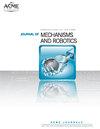具有分段腿的四肢模板模型的新兴步态
IF 3.2
4区 计算机科学
Q2 ENGINEERING, MECHANICAL
Journal of Mechanisms and Robotics-Transactions of the Asme
Pub Date : 2023-04-20
DOI:10.1115/1.4062388
引用次数: 1
摘要
步行机器人中的节能步态可以通过设计表现出自然出现的运动模式的弹性系统来获得。生物腿运动是一种灵感,因为动物使用不同的步态以特定的速度移动,同时最大限度地减少能量消耗。为了理解生物运动的潜在动力学,已经提出了简化的模型。最常见的是SLIP(弹簧加载倒立摆)模型,它可以解释线性腿的径向弹性的影响,并有助于解释不同腿系统中的运动模式,尤其是跑步行为。不幸的是,SLIP模型不适合研究具有关节腿的系统的极限循环稳定性,而关节腿是真实机器人中最常用的。本文介绍了一种新型的四足动物模型,该模型具有关节弹性腿、非恒定腿刚度和动态腿摆动。使用连续方法的数值模拟来发现模型自然动力学中出现的步态,而不预先施加任何接触序列。这些步态的稳定性也得到了表征,以便于利用自然模型动力学来生成四足机器人的运动模式本文章由计算机程序翻译,如有差异,请以英文原文为准。
Emerging Gaits for a Quadrupedal Template Model with Segmented Legs
Energy-efficient gaits in walking robots can be obtained by designing elastic systems that exhibit naturally emerging locomotion patterns. Biological legged locomotion serves as inspiration, as animals use different gaits to move at certain speeds while minimizing energy consumption. To understand the underlying dynamics of biological locomotion, simplified models have been proposed. The most common one, the SLIP (Spring Loaded Inverted Pendulum) model, can explain the effect of the radial elasticity of linear legs and helps to explain locomotion patterns, especially for running behaviors, in different legged systems. Unfortunately, the SLIP model is inappropriate for the study of stability of limit cycles in systems with articulated legs, which are most commonly used in real robots. This paper introduces a novel quadrupedal template model featuring articulated elastic legs, non-constant leg stiffness, and dynamic leg swing. Numerical simulation with a continuation approach is used to discover the gaits emerging from the natural dynamics of the model, without imposing any contact sequence a priori. The stability of those gaits is also characterized, in order to facilitate the exploitation of the natural model dynamics for generating locomotion patterns for quadrupedal robots
求助全文
通过发布文献求助,成功后即可免费获取论文全文。
去求助
来源期刊

Journal of Mechanisms and Robotics-Transactions of the Asme
ENGINEERING, MECHANICAL-ROBOTICS
CiteScore
5.60
自引率
15.40%
发文量
131
审稿时长
4.5 months
期刊介绍:
Fundamental theory, algorithms, design, manufacture, and experimental validation for mechanisms and robots; Theoretical and applied kinematics; Mechanism synthesis and design; Analysis and design of robot manipulators, hands and legs, soft robotics, compliant mechanisms, origami and folded robots, printed robots, and haptic devices; Novel fabrication; Actuation and control techniques for mechanisms and robotics; Bio-inspired approaches to mechanism and robot design; Mechanics and design of micro- and nano-scale devices.
 求助内容:
求助内容: 应助结果提醒方式:
应助结果提醒方式:


